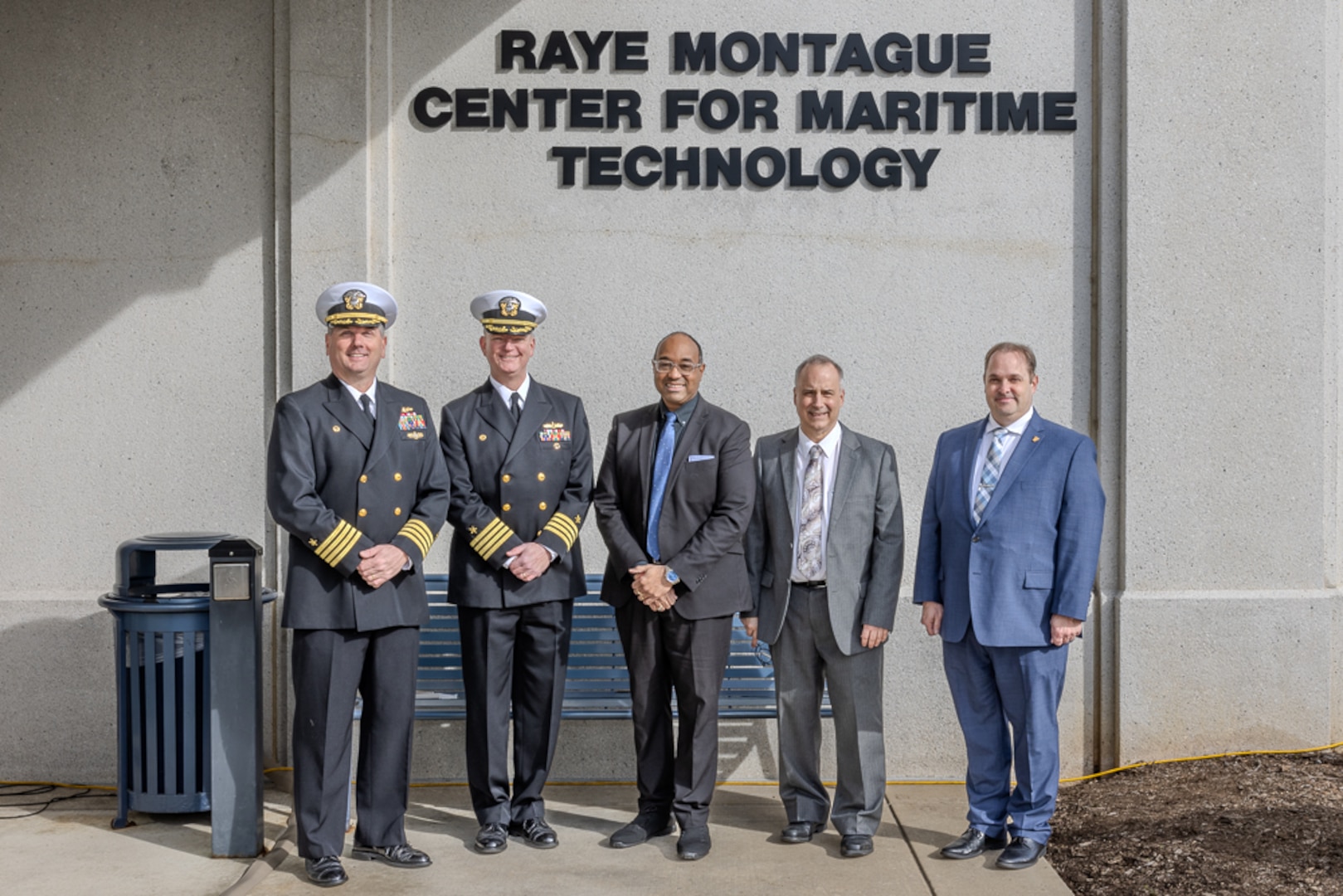By Edvin Hernandez and Kelley Stirling, NSWC Carderock Division Public Affairs
February and March mark two significant months that recognize Black History and Women’s History in the United States, respectively. It’s a time that reminds American citizens of the struggle, resilience and empowering courage historical figures like Martin Luther King Jr., Rosa Parks, Jesse Owens, Harriet Tubman and Ruth Bader Ginsburg, to name a few, encountered in transforming America to what it is today. As the U.S. celebrates and remembers their accomplishments, Naval Surface Warfare Center (NSWC), Carderock Division honored one of its own with the renaming of a federally owned building.
Chief of Naval Operations Adm. Lisa Franchetti signed a letter in August 2023 approving the renaming of Carderock’s Maritime Technology Information Center, located in Building 40, in West Bethesda, Maryland, after a naval icon, Raye Montague. Carderock marked this historic event by hosting a ceremony on Feb. 15, 2024, unveiling the new name of Building 40 to the Raye Montague Center for Maritime Technology.
Montague, who was the first person ever to design a ship using a computer, posthumously received this dedication for her contributions to the U.S. Navy. Dr. David Montague, Raye’s son, attended the event with his family. Other speakers included Carderock Commanding Officer Capt. Matthew Tardy, Carderock Technical Director Larry Tarasek and Warfare Centers Executive Director Dr. Marty Irvine.
“This building is a conference center, built in 2007 for the purpose of accommodating the members of this command in their mission, which is to conduct world-class ship design and engineering,” Tardy said. “Carderock is Where the Fleet Begins and Raye Montague is where computer ship design begins. It’s an honor for us to have this building named after her.”
Prior to making the renaming official, Tardy penned a letter to Montague’s son, David, to inform him of the approval and ask for his permission to proceed with the renaming.
“I know your mother faced many hurdles along the way, especially at the start of her career,” Tardy wrote in his letter. “That is why this special honor is so important to future generations and us. It reminds us of where we were and gives us the opportunity to see how far we have come and how very far we have yet to go.”
Dr. Montague, the Associate Vice Chancellor for Academic Affairs and Student Success at the University of Arkansas at Little Rock, accepted both the proposal and invitation to speak at the event.
“This is an emotional moment for me because I spent a significant amount of my youth at this facility, running around and learning how to program computers,” Dr. Montague said. “The sheer time and effort that everyone put in to turn this idea into reality – just like ship design – is incredible. I grew up as a child of Naval Sea Systems Command – NAVSEA runs in my blood. To be here and see this building dedicated in her honor is overwhelming.”
Dr. Montague co-wrote a biography about his mother with Paige Bowers, who was unable to attend the ceremony. He followed the ceremony with a book discussion about his mother’s life.
“I think it is a fitting tribute to her, and I think this is something that will be educational for anyone who visits this building,” he said. “My mother started in the Applied Mathematics Lab at Carderock, and she did a lot of her formative, early career opportunities when she moved from Arkansas – during segregation – to Maryland, and the Navy gave her that opportunity. Although she faced obstacles like being a woman coming from a state where women were not encouraged to study STEM, she overcame it, and that was special. She built a trusting network at Carderock, which is important because that team building and that effort to make a difference is what laid the ground work for her to become the first female program manager of ships. She opened doors for other people.”
As a black woman living in the 1950s, Montague encountered several hurdles that prevented her from pursuing engineering programs in college. Although she had wanted to study engineering, at the time, no colleges in Arkansas permitted such degrees to female African-American students. Instead, she studied business and graduated Arkansas Agricultural, Mechanical and Normal College – now the University of Arkansas at Pine Bluff – with a Bachelor’s of Science in business in 1956. During her time in college, however, Montague also took night courses in computer programming; and upon graduation, she began her civilian career as a clerk typist at the David Taylor Model Basin, now known as NSWC Carderock Division, in Bethesda, Maryland.
Montague quickly showed her aptitude in science and math, which would eventually lead her to be reassigned to work with the new Universal Automatic Computer I (UNIVAC I) system, the world’s first commercially available computer.
A few years later, she would take on a new position as a digital computer systems operator at the Naval Ship Engineering Center in Hyattsville, Maryland. While there, she was charged with modifying and reconfiguring the massive ship specifications automation system known as Computer-Aided Ship Design and Construction (CASDAC).
When she completed this “impossible task” within her deadline, Montague was eventually asked to design a ship, again with what her bosses thought to be an impossible deadline of one month, after President Richard Nixon said the Navy had two months instead of two years to get it done.
Montague is credited with designing the first draft of the Oliver Hazard Perry-class frigate in 1971 in less than 19 hours, earning her a Meritorious Civilian Service Award and revolutionizing ship design from that day forward. Montague’s dream of becoming an engineer was realized later in her career, ultimately becoming the program director for Naval Sea Systems Command’s Integrated Design, Manufacturing and Maintenance Program.
Her illustrious career has seen her inducted into Arkansas’ Black Hall of Fame and Women Hall of Fame, as well as being dubbed the Navy’s own “Hidden Figure.”
“The work that is being done here at Carderock could not be achieved without pioneers like Raye Montague who went before us,” Irvine said during the ceremony. “Ms. Montague not only made computer-aided ship design a commonplace, but paved the way for people that followed in her footsteps, including those who are driven to get things done, deliver solutions, and serve our country, as she did.”
Tarasek talked about Carderock’s role in ship design and the creation of new design tools such as the computational Research and Engineering Acquisition Tools and Environments for ship design, also known as CREATE Ships.
“We owe a lot in the way we design ships to Raye Montague,” Tarasek said. “And we owe a lot in how we recognize the importance of diversity and inclusion to Raye Montague. The least we can do is name a building after her.”
Phone: 202-781-4123
Email: usn.ncr.sea-00.mbx.navsea-public-affairs@us.navy.mil
Commander Naval Sea Systems Command
1333 Isaac Hull Avenue, SE
Washington Navy Yard, DC 20376
202-781-0000

